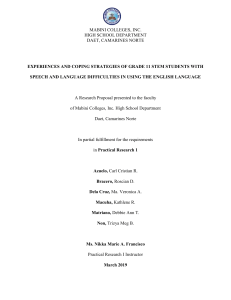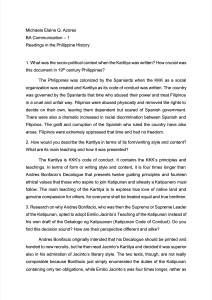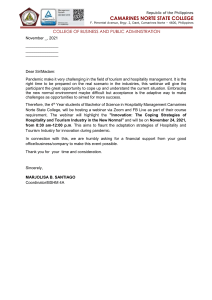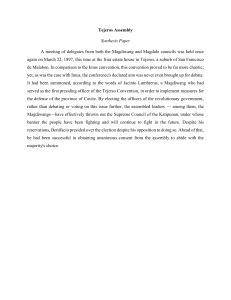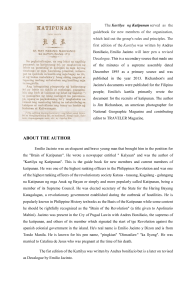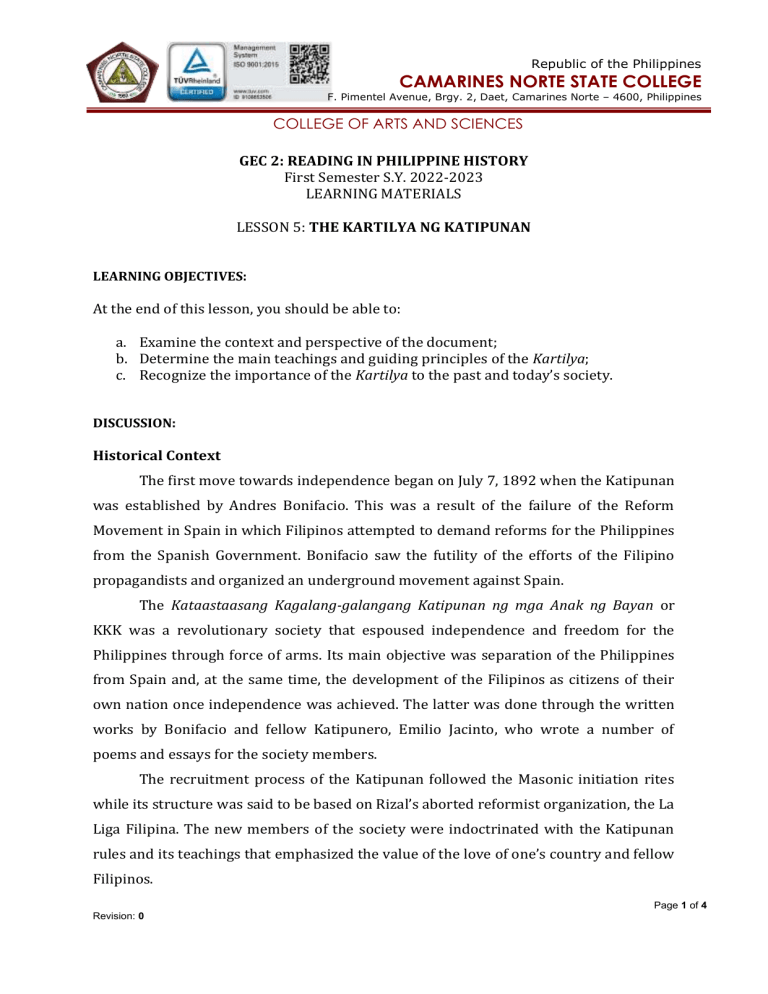
Republic of the Philippines CAMARINES NORTE STATE COLLEGE F. Pimentel Avenue, Brgy. 2, Daet, Camarines Norte – 4600, Philippines COLLEGE OF ARTS AND SCIENCES GEC 2: READING IN PHILIPPINE HISTORY First Semester S.Y. 2022-2023 LEARNING MATERIALS LESSON 5: THE KARTILYA NG KATIPUNAN LEARNING OBJECTIVES: At the end of this lesson, you should be able to: a. Examine the context and perspective of the document; b. Determine the main teachings and guiding principles of the Kartilya; c. Recognize the importance of the Kartilya to the past and today’s society. DISCUSSION: Historical Context The first move towards independence began on July 7, 1892 when the Katipunan was established by Andres Bonifacio. This was a result of the failure of the Reform Movement in Spain in which Filipinos attempted to demand reforms for the Philippines from the Spanish Government. Bonifacio saw the futility of the efforts of the Filipino propagandists and organized an underground movement against Spain. The Kataastaasang Kagalang-galangang Katipunan ng mga Anak ng Bayan or KKK was a revolutionary society that espoused independence and freedom for the Philippines through force of arms. Its main objective was separation of the Philippines from Spain and, at the same time, the development of the Filipinos as citizens of their own nation once independence was achieved. The latter was done through the written works by Bonifacio and fellow Katipunero, Emilio Jacinto, who wrote a number of poems and essays for the society members. The recruitment process of the Katipunan followed the Masonic initiation rites while its structure was said to be based on Rizal’s aborted reformist organization, the La Liga Filipina. The new members of the society were indoctrinated with the Katipunan rules and its teachings that emphasized the value of the love of one’s country and fellow Filipinos. Page 1 of 4 Revision: 0 Republic of the Philippines CAMARINES NORTE STATE COLLEGE F. Pimentel Avenue, Brgy. 2, Daet, Camarines Norte – 4600, Philippines COLLEGE OF ARTS AND SCIENCES About the Author Emilio Jacinto was born on December 15, 1875 in the district of Trozo in Tondo, Manila. He was the son of Mariano Jacinto, a bookkeeper, and Josefa Dizon. Living a life of poverty, Jacinto still managed to get a good education. He finished his elementary education in a private school then took up his secondary education at the Colegio de San Juan de Letran. He later studied law at the University of Santo Tomas where he developed a love of reading and improved his skills in Spanish. Unfortunately, he had to stop his studies when the Philippines Revolution began in 1896. Jacinto joined the Katipunan in 1894 at the age of 18 and took the symbolic name Pingkian. It was during this time that he developed his nationalistic ideals. Through his enthusiasm and ideas, Jacinto became a guiding light to the members of the society. He wrote the Kartilya as well as the oath of Katipuneros. He also edited the Katipunan newspaper, Kalayaan, and was the author of several literary writings using the prename “Dimas Ilaw”. He served the Katipunan in different capacities such as secretary, fiscal, editor, and later was appointed General by Bonifacio in 1897. He also served as an adviser to the Supremo. After the death of Bonifacio in Cavite in 1897, Jacinto continued the fight against the Spaniards even after the truce following the Pact of Biak-na-Bato. He was wounded in a battle against the Spaniards in Magdalena, Laguna and was captured. Upon investigation, Jacinto was released after he managed to convince the Spanish soldiers he was a spy in their service when he showed them a military pass issued to a man he killed several months ago. Jacinto quickly went into hiding in Manila. There he sent a letter to Apolinario Mabini in Malolos, Bulacan stating his plan to continue his law studies at the newly-established Literary University of the Philippines. But this plan was discontinued when Jacinto had to go back to Laguna to lead his fellow patriots in the war against the new enemy, the Americans. He established his headquarters in the town of Majayjay where he, unfortunately, contracted malaria. He died on April 6, 1899. Page 2 of 4 Revision: 0 Republic of the Philippines CAMARINES NORTE STATE COLLEGE F. Pimentel Avenue, Brgy. 2, Daet, Camarines Norte – 4600, Philippines COLLEGE OF ARTS AND SCIENCES About the Text In his study of the Katipunan history and its documents, Jim Richardson said that “the Kartilya is the best known of all Katipunan texts” and that it is “the only document of any length set in print by the Katipunan prior to August 1896 that is known to be still extant.” The Kartilya was printed as a small pamphlet that was distributed to the members of the Katipunan. Its term was derived from the Spanish cartilla which was the primer used for grade schools during the Spanish period. And like the cartillas, this document served as the primary lessons for the members of Katipunan. The Kartilya presents not only the teachings for the neophyte Katipunero but also the guiding principles of the society. These teachings are expected from the members even after the attainment of freedom from the colonizers. The Kartilya ends with a document of affirmation by the member to the society’s teachings. The Kartilya was not just a document for the Katipunan. Its importance today is predicted on the teachings that embodied the moral and nationalistic principles of a nation that fought for independence. These principles are relevant as the sense of nationhood still holds true when the cultural and historical values of every Filipino are threatened by the onslaught of foreign influences brought about by today’s globalization. Relevance The current relevance of the Kartilya lies in the fact that it established not only the rules for the members of the organization but the principles for the citizens of a nation once independence had been achieved. Though written in the 19th century, the Kartilya is significant to the lives of modern Filipinos as it reads like a simple creed for living in the light of the many changes occurring at present. EVALUATION: (See the separate file for Learning Activity) REFERENCES: Torres, Jose Victor. BATIS: Sources in Philippine History. C&E Publishing Inc. (2018) Page 3 of 4 Revision: 0 Republic of the Philippines CAMARINES NORTE STATE COLLEGE F. Pimentel Avenue, Brgy. 2, Daet, Camarines Norte – 4600, Philippines COLLEGE OF ARTS AND SCIENCES Asuncion, Nestor M. et. al. Readings in Philippine History. C&E Publishing Inc. (2019) Prepared by: John Rey R. Buan Instructor Page 4 of 4 Revision: 0


